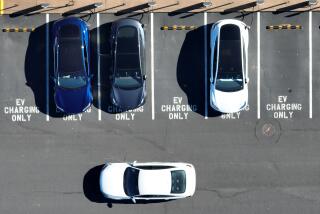Ways to Keep Your Car Looking New
- Share via
Is there any scent as intoxicating as that of a new car’s interior?
Well, OK, maybe there are some. But the average Jane and Joe will surely rate “new car smell” right up there in the top 10.
Though that odor will naturally fade with time, there are plenty of steps you can take with your new car or truck to keep it as “new” as possible for as long as possible--and most of these rules will apply to your used-car purchases as well.
And remember: All the time and money you spend on your car’s cosmetic care comes right back to you when it’s time to sell or trade in.
*
Interior Care: Since you’re going to spend most of your time inside the vehicle, let’s start there. First and foremost, if you have kids (or pets), check to see if your interior’s seating and carpeted surfaces can be coated with a protectant by the dealer or at the factory--before you even take delivery. With messy families in mind, many minivans already come standard with Scotchguard or a similar fabric treatment.
Find out too how often it might be necessary to reapply that treatment to keep the protection active. You might find that the dealer will offer a reapplication as part of its customer service package. It’s worth asking.
In sunny SoCal, it’s a must to try to cut down on the amount of heat and ultraviolet rays getting into the vehicle’s interior. This is where the standard, familiar vinyl treatments come into play. Use the product liberally, and according to directions, on the dashboard and rear package shelf (that area below the rear window).
Most of these UV-blocking treatments are quite slippery, so don’t use them on the steering wheel, pedals, gearshift knob or seating surfaces.
You might also want to consider window tinting. A shop specializing in tinting (check to see if it is a member of a tinting trade association) can give you the latest legal information on which windows can be treated and how much tint can be applied. Window tint is a great idea because it cuts down on the “heat load” generated by sunlight and UV rays, thus making it easier for your air conditioning to initially cool the interior. And that actually saves you fuel.
Within five years, experts tell us, window and sunroof tinting will be accomplished automatically by microscopic particles floating between the vehicle’s glass layers, turning the tint on and off as needed. But in the meantime, check out today’s available tinting options.
*
Exterior Care: You may live on the inside, but it’s the outside of your car or truck that lets your neighbors know how much you care for your baby--and also determines much of the value when it comes time to sell or trade in.
If your car is available with the optional rubber or plastic moldings meant to protect the side panels from parking lot door nicks, get them. Although a process called “paintless dent removal” is an effective, inexpensive way to take care of door dings without replacing and repainting sheet metal, not having the ding in the first place is the best protection against having to spend extra bucks.
If your new car or truck comes from the factory with a “clear coat” over all the painted surfaces; this protective layer of clear paint, if properly maintained, will last many years and keep the paint job looking good.
Keeping that clear coat in top shape is your most important exterior care job, and the best way to do it is to buy a high-quality car cover and use it whenever the vehicle is parked outside. Locking car covers (so they’ll still be on the car when you come back) made of special fabrics that allow the car’s paint to “breathe” are well worth the investment of up to $200 or so.
DuPont’s Evolution fabric seems to be the cover material of choice, but there are several others on the market, so check them all out. Southern California has dozens of shops and mail-order businesses specializing in car covers, so you’ll have little trouble getting all your questions answered.
The other secret to maintaining that clear coat is to keep it clean. There are a number of high-quality, low-abrasion cleaners on the market made specifically for clear coat, and there are also special clay bars that can be used with a little elbow grease to pick up even microscopic dirt particles.
Once dirt, acid rain, tree sap, smog and bird droppings mix with UV rays and heat to get under the clear coat, you’ll have to deal with a rust problem, and that’s a much more expensive proposition than just keeping the clear coat clean. And remember too: If the clear coat is scratched, you’ll have to cover it with some sort of enamel, although that’s something you can do yourself if the scratch is small enough.
We’ve covered wheel and tire care in a previous column, but the short solution is: Use a UV-blocking tire “dressing” on tire sidewalls (not the tread!) to aid in long life, and find out if your wheels have a clear coat and treat them accordingly. California’s sun and heat wreak havoc on rubber, and some tire experts tell us that smog and UV rays damage tires more than driving on the freeways.
And, yes, you can even buy a bottle of “new car smell” to spray in the car if all else fails--or if you’re just lazy.
*
Car Care Month: The Automobile Club of Southern California is offering free auto checkups throughout October as part of its participation in National Car Care Month.
Auto Club members and nonmembers alike can take advantage of the 38-point inspections offered by more than 700 garages throughout Southern California that the club has designated as approved auto repair facilities. The AAR garages undergo annual inspections by Auto Club experts to ensure that they provide quality service from trained technicians using proper equipment.
Checkups are by appointment only. Contact any Auto Club office or visit the club’s Web site at https://www.aaa-calif.com to find the closest AAR garage.
Steve Parker is the auto expert on KCBS-TV Channel 2 News every Tuesday and Thursday mornings and host of “The Car Nut,” a call-in program airing Sunday from 7 to 9 a.m. on KXTA-AM (1150). He can be reached via e-mail at steve@steveparker.com.
* CARE PACKAGE: Car Care “back issues” are available on the Highway 1 Web site: https://www.latimes .com/highway1






